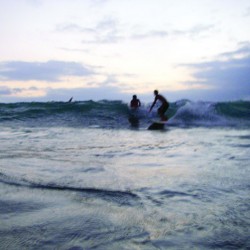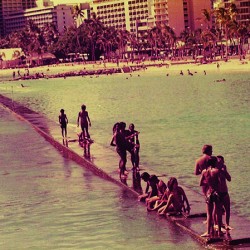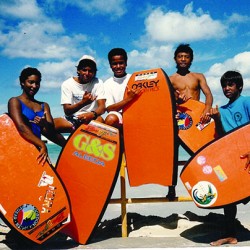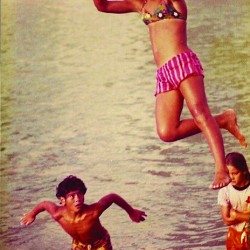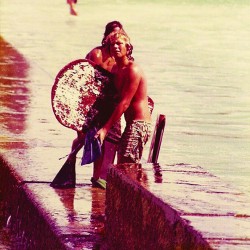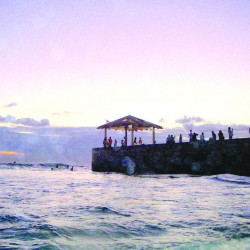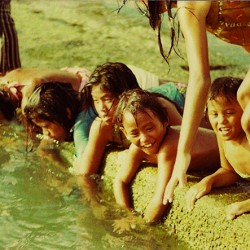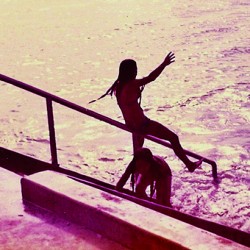Off the Walls
A unique feature of Waikiki Beach—walls, aka the Kapahulu Groin—holds a special place in the hearts of locals and tourists alike.
When most people imagine the beaches of Waikiki, they don’t think of concrete walls. But the truth is that “Walls” defines Waikiki for bodyboarders and for local beachgoers who claim it as their own best place to hang out on the south shore of O‘ahu.
Also known as “The Wall,” and as the Kapahulu Groin to most Honolulu City and County government officials, Walls stands as one of the most unique manmade features in all of Waikiki—one that holds special meaning for many of O‘ahu’s watermen and waterwomen.
The Wall was built in 1951 to create a beach where little sand ever existed. Ocean currents, based on seasonal tides, would bring sand in and take it away. However, for centuries, nothing qualifying as a substantial beach ever remained.
Commercial air travel from the U.S. mainland to Hawai‘i became possible in the 1930s and steadily increased into the 1950s and beyond. With the possibility of massive commercial air travel only a decade away, officials and businessmen in the islands were already envisioning Waikiki as a tourist haven.
Potential visitors to the Hawaiian Islands were, more than anything, looking for the warm sun, golden sand and azure ocean that they had been reading about in magazines. After all, only a few years remained before Hawai‘i would become the fiftieth state.
Throughout these pivotal years for the creation of a “modern Hawai‘i,” Waikiki was being revisioned as a place for people from around the world to be welcomed into island culture and to celebrate the Tiki Era. The wetlands that had once defined Waikiki (“spouting fresh water”) and that had been crafted into loko (fishponds) and lo‘i (taro terraces) by ancient Hawaiians (used later by Asian immigrants for cultivation of rice) had been filled in. Upon the now-solid land, hotels, restaurants and bars were redefining the Waikiki landscape.
- PHOTO: DEBI SIEGEL
- PHOTO: DEBI SIEGEL
- PHOTOS: JOHN “LYLE” MONTGOMERY
The problem was that true beaches in Waikiki were hard to come by. Sand to create such beaches just wouldn’t stay put. Starting in the 1920s and extending into today, various “erosion control projects” were implemented in an effort to create land where there once was only sea.
The plan for Waikiki was that sand would be brought in from other places to fashion a deeper beach than nature provided. In the early years of the efforts to battle erosion, sand was shipped by barge all the way from Manhattan Beach, California. Sand would also be shifted from Waimanalo and Kane‘ohe here on O‘ahu to help Waikiki maintain her luster. Most recently, within the past few years, sand has been siphoned from just off shore and deposited along the beach.
In addition, various structures were built extending from Waikiki’s shoreline to help keep the new sand in place. One such creation was the Kapahulu Groin. The lesser-known definition of the word “groin” is that of a low wall or barrier built out into the sea to prevent or lessen erosion. This particular retaining wall stretches straight out into the ocean as an extension of a storm drain in the area where Kuekaunahi Stream, having flowed from the Ko‘olau mountain range, once fortified the wetlands of Waikiki before entering the sea.
The Kapahulu Groin exists as a true division line for Waikiki. To the Diamond Head side of The Wall, one finds Queen’s Beach. Significant is the realization that the procession of hotels and highrises ends at The Wall. Also notable is the fact that, from Walls to the Natatorium, the inner waters of Waikiki are designated as a fishing sanctuary. A small sign on the beach at Walls confirms this statute. No one can fish or hunt for he‘e (octopus or squid) within that span of the shoreline’s ocean, thus making snorkeling at The Wall ideal.
Another element that defines The Wall as “ideal” is the fact that it’s one of O‘ahu’s pristine places for bodyboarding. Contests for both professionals and amateurs are held here every year, and some of the world’s most renowned bodyboarders have crafted their art here for decades. As generations of locals have made Walls their go-to for bodyboarding, a distinct group has defined this place as their watery home-away-from-home. They are affectionately and intimately called “Wall Rats.” Some of the most notable individuals who started out as Wall Rats include Dino Miranda and Bonga Perkins—watermen who would rise to the top of their respective fields as world champions and claim titles in bodyboarding and surfing for years.
Even now, a key part of the annual Duke’s Oceanfest celebration, commemorating famed Native Hawaiian waterman Duke Kahanamoku, takes place in the water to the Kuhio side of the Kapahulu Groin. Just as Duke, his brothers and fellow beachboys did it in the 1920s and 1930s, six-person teams compete by playing water polo while on surfboards perpetuating the “surf-polo” tradition.
The Wall itself stands as a pedestrian promenade for visitors who either want to mimic the feel of walking on a pier or experience the romance of the islands. They walk out into the ocean and take pictures beneath the gazebo, and to either side, families frolic in the sand and sea, and keiki (children) learn how to swim.
One mainland transplant who has come to love The Wall just as much as the rest of the Wall Rats is Debi Siegel. She’s even created a Facebook page and a website dedicated to this magical, manmade place. She recounts, “One of the main things I love about Walls is all the little kids. The teeny, weeny little kids would come here and get started bodyboarding. They’d move on to Sandy’s and Makapu‘u, of course, but they started here. Some even go on to become Pipeline Champions.”
The water is alive at Walls—the boarders rocking the waves, the fish feeling content in their sanctuary, the children playing and exploring and the old teaching the young the ways of the past. There’s an instantaneous excitement when a wave hits The Wall and its splash flies up into the air. As each droplet falls on a local, it brings the reminder that he or she is part of Walls and the history of Waikiki. As each droplet falls on a visitor, it introduces a bit of that history and the wonder of this place.
As any Wall Rat can tell you just before jumping off The Wall into the water to create his or her own spectacular splash, Walls is a gathering place surging with an energy all its own.
PHOTOS: JOHN “LYLE” MONTGOMERY | WWW.WAIKIKIWALL.COM
DEBI SIEGEL | WWW.FACEBOOK.COM/WAIKIKIBEACHWALLS





